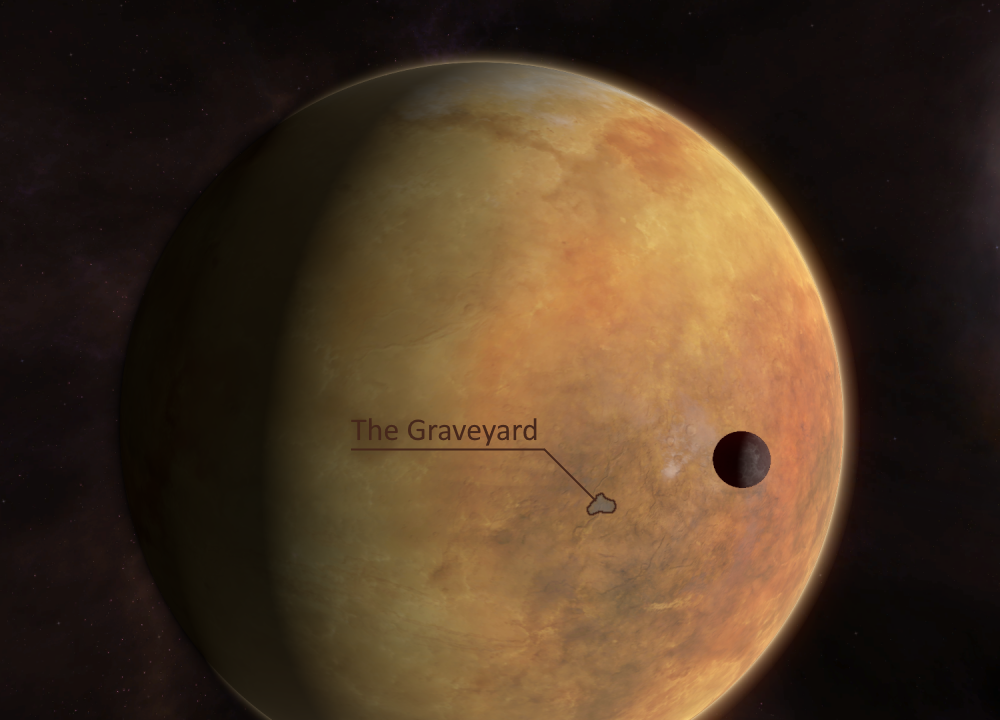Buried beneath seventy meters of water and sediments in one of the Calderan Lakes, the first Archean wreckage found was in an extremely deteriorated state, but was the undeniable proof that Humanity was not the only civilization in the universe. After this discovery, numerous imperial expeditions were sent to unearth the secrets of Charon and its Archean artifacts. New sensors, calibrated to the Archean metals and magnetic signatures, allowed for a deep cartography of the region, which eventually became known as the Graveyard due to the ruins' nature and repartition.
As a strategically essential location of the Ascendancy, the Graveyard quickly became a major point of interest for both imperial scientists and the imperial military. The Graveyard itself became military property, with large fortifications built all around it to prevent unauthorized entry by scavengers and spies. Laboratories and research stations were built in the vicinity, eventually forming the city of Howl s Edge. As ruins were explored, studied and sometimes scrapped for resources or repurposed, the city progressively grew to its current size, becoming the capital of Charon and encompassing parts of what used to be the military's territory. The Graveyard's unique geological and biological features make the city a popular destination for scientists of all kinds, even to this day.
Human development
Since the beginning of the 4th century, human development in the Archean region have become increasingly present. Howl's Edge, previously confined to the outskirts of the Graveyard, has now grown to cover more than 16% of the region, exploiting its water reserves and somewhat fertile land to sustain its residents. Some of the ruins present within the city have been repurposed as museums or other buildings, as their content have either been transferred or lost its value, and have become a symbol for the city. Military presence in the region has also drastically increased with the recent incursions of Vestan fugitives within the Ascendancy, and the region is now frequently patrolled by land and air forces stationed at the nearby bases.
Geology and physical features
The Archean region has a highly unnatural geological composition. Due to the numerous ruins, the soil is rich in rare and heavy metals, as well as traces of alloys, and forms irregular shapes throughout the region. The soil composition prevents most of the surface water to permeate any deeper, causing the apparent rivers and lakes to take form despite the harsh weather. With these unnatural bodies of water, erosion was much slower than predicted, leading to layers of sediments to form on the submerged ruins. These ruins have been found as deep as 600 meters, where the most preserved artifacts have been found, and are scattered throughout the region in an irregular pattern, forming interconnected canyons, mountains and caves.
The largest ruin, the Ring, is a torus structure with a presumed diameter of 47 km found 483m beneath the surface. Only half of it has been excavated and explored as of 383, with its original purpose all but lost to time. The most famous ruin, however, is the Obelisk. A tall structure, half submerged and half buried into the adjacent cliff, is the first ruin discovered by Dr. Favre. Due to its shape and position, it is believed to be a ship that crashed vertically, or was built vertically. With landslides and water damaging it for millennia, however, most of the ruin's interior is nothing but a maze of caves and crevices, with very few traces of civilization left to study.
Climate
The Archean region is known for its strong winds and frequent sandstorms, as the irregular landscape tends to funnel air streams together. Due to its high concentration of atmospheric water vapor, it is also the only place on Charon with relatively frequent rain, helping the local flora against the extreme temperatures. During the hottest seasons, it is not uncommon for the region to reach temperatures of up to 46°C, and in contrast, down to freezing temperatures of -15°C in the coldest seasons. The sudden temperature fluctuations at dusk and dawn, where the sunlight is no longer present, often causes distant shrieks and howls, sounds which are attributed to the metallic ruins expanding and compressing. This phenomena gave its name to Howl's Edge and are frequently called the Archean Choir.
Flora
Despite Charon's barren landscape and extreme temperatures, plant life has grown and thrived around the Archean region. This is primarily due to the region's liquid water, and subsequently high water vapor concentration, that preserved the local flora from the most dangerous sandstorms. As a result, the region is full of endemic plant species, such as the Spike Trees and the Silver Moss, that dot the land and helped regulate Charon's atmosphere. While the planet still isn't suited for human life, it's current atmospheric pressure and composition is mostly attributed to the work of the Archean flora.
Fauna
The Archean region has very little wild fauna, consisting only of a few insect, aquatic and reptilian species. It does, however, have a rather rich bacterial ecosystem that has been deeply studied by imperial biologists. In more recent years, Howl's Edge has built several pisciculture facilities in the Calderan Lakes, bringing new aquatic species into the region.




Gotta love some ancient, alien ruins :D Are there any significant discoveries that have been made here? New tech, old secrets, that sort of dramatic thing?
Creator of Araea, Megacorpolis, and many others.
Hello, and thank you for your comment! There sure are some dark secrets tied to this place, but I will keep that for another time. Other discoveries were made here, but I am unsure where to reference them, any suggestions?
The sidepanel is looking pretty barren - maybe that'd be a good place?
Creator of Araea, Megacorpolis, and many others.